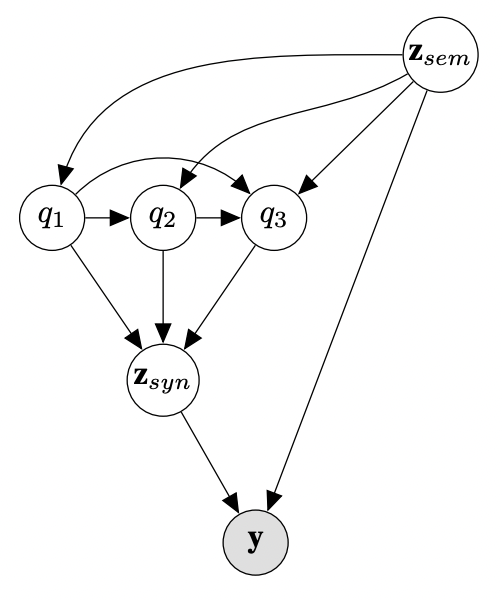This repo contains the code for the paper Hierarchical Sketch Induction for Paraphrase Generation, by Tom Hosking, Hao Tang & Mirella Lapata (ACL 2022).
We propose a generative model of paraphrase generation, that encourages syntactic diversity by conditioning on an explicit syntactic sketch. We introduce Hierarchical Refinement Quantized Variational Autoencoders (HRQ-VAE), a method for learning decompositions of dense encodings as a sequence of discrete latent variables that make iterative refinements of increasing granularity. This hierarchy of codes is learned through end-to-end training, and represents fine-to-coarse grained information about the input. We use HRQ-VAE to encode the syntactic form of an input sentence as a path through the hierarchy, allowing us to more easily predict syntactic sketches at test time. Extensive experiments, including a human evaluation, confirm that HRQ-VAE learns a hierarchical representation of the input space, and generates paraphrases of higher quality than previous systems.
First, create a fresh virtualenv and install the dependencies:
pip install -r requirements.txt
Then download (or create) the datasets/checkpoints you want to work with:
Download a pretrained checkpoint for Paralex
Download a pretrained checkpoint for QQP
Download a pretrained checkpoint for MSCOCO
Checkpoint zip files should be unzipped into ./models, eg ./models/hrqvae_qqp. Data zip files should be unzipped into ./data/.
Note: Paralex was originally scraped from WikiAnswers, so many of the Paralex models and datasets are labelled as 'wa' or WikiAnswers.
Note 2: As per this issue, the dataset splits used in the paper for MSCOCO and QQP (based on official splits) are actually somewhat leaky. We recommend using deduped versions of these splits (eg here for QQP)for future work.
To replicate our results (eg for QQP), have a look at the example in ./examples/Replication-QQP.ipynb.
You can also run the model on your own data:
import json
from torchseq.agents.para_agent import ParaphraseAgent
from torchseq.datasets.json_loader import JsonDataLoader
from torchseq.utils.config import Config
import torch
# Which checkpoint should we load?
path_to_model = './models/hrqvae_paralex/'
path_to_data = './data/'
# Define the data
examples = [
{'input': 'What is the income for a soccer player?'},
{'input': 'What do soccer players earn?'}
]
# Change the config to use the custom dataset
with open(path_to_model + "/config.json") as f:
cfg_dict = json.load(f)
cfg_dict["dataset"] = "json"
cfg_dict["json_dataset"] = {
"path": None,
"field_map": [
{"type": "copy", "from": "input", "to": "s2"},
{"type": "copy", "from": "input", "to": "s1"},
],
}
# Enable the code predictor
cfg_dict["bottleneck"]["code_predictor"]["infer_codes"] = True
# Create the dataset and model
config = Config(cfg_dict)
data_loader = JsonDataLoader(config, test_samples=examples, data_path=path_to_data)
checkpoint_path = path_to_model + "/model/checkpoint.pt"
instance = ParaphraseAgent(config=config, run_id=None, output_path=None, data_path=path_to_data, silent=True, verbose=False, training_mode=False)
# Load the checkpoint
instance.load_checkpoint(checkpoint_path)
instance.model.eval()
# Finally, run inference
_, _, (pred_output, _, _), _ = instance.inference(data_loader.test_loader)
print(pred_output)
['what is the salary for a soccer player?', 'what do soccer players earn?']
If you want to generate multiple diverse paraphrases for each input (aka 'top-k' inference), have a look at ./examples/topk.ipynb.
Train a fresh checkpoint using:
torchseq --train --config ./configs/hrqvae_paralex.json
To use a different dataset, you will need to generate a total of 4 datasets. These should be folders in ./data, containing {train,dev,test}.jsonl files.
An example of this process is given in ./scripts/MSCOCO.ipynb.
{"qs": ["What are some good science documentaries?", "What is a good documentary on science?", "What is the best science documentary you have ever watched?", "Can you recommend some good documentaries in science?", "What the best science documentaries?"]}
{"qs": ["What do we use water for?", "Why do we, as human beings, use water for?"]}
...
The sentences must be in the same order as in the cluster dataset!
{"q": "Can you recommend some good documentaries in science?"}
{"q": "What the best science documentaries?"}
{"q": "What do we use water for?"}
...
Generate this using the following command for question datasets:
python3 ./scripts/generate_training_triples.py --use_diff_templ_for_sem --rate 1.0 --sample_size 26 --extended_stopwords --real_exemplars --exhaustive --template_dropout 0.3 --dataset qqp-clusters --min_samples 0
Or this command for other datasets:
python3 ./scripts/generate_training_triples.py --use_diff_templ_for_sem --rate 1.0 --sample_size 26 --pos_templates --extended_stopwords --no_stopwords --real_exemplars --exhaustive --template_dropout 0.3 --dataset mscoco-clusters --min_samples 0
Replace qqp-clusters with the path to your dataset in "cluster" format.
For each cluster, select a single sentence to use as the input (assigned to sem_input) and add all the other references to paras. tgt and syn_input should be set to one of references.
{"tgt": "What are some good science documentaries?", "syn_input": "What are some good science documentaries?", "sem_input": "Can you recommend some good documentaries in science?", "paras": ["What are some good science documentaries?", "What the best science documentaries?", "What is the best science documentary you have ever watched?", "What is a good documentary on science?"]}
{"tgt": "What do we use water for?", "syn_input": "What do we use water for?", "sem_input": "Why do we, as human beings, use water for?", "paras": ["What do we use water for?"]}
...
Have a look at the config files, eg configs/hrqvae_qqp.json, and update all the references to the different datasets, then run:
torchseq --train --config ./configs/hrqvae_mydataset.json
Have a look at ./src/hrq_vae.py for our implementation.
@inproceedings{hosking-etal-2022-hierarchical,
title = "Hierarchical Sketch Induction for Paraphrase Generation",
author = "Hosking, Tom and
Tang, Hao and
Lapata, Mirella",
booktitle = "Proceedings of the 60th Annual Meeting of the Association for Computational Linguistics (Volume 1: Long Papers)",
month = may,
year = "2022",
address = "Dublin, Ireland",
publisher = "Association for Computational Linguistics",
url = "https://aclanthology.org/2022.acl-long.178",
pages = "2489--2501",
}



